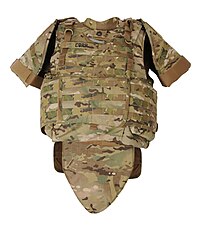
Photo from wikipedia
The ballistic response of armor has been widely used to evaluate its feasibility and advantages as a protective structure. To obtain the ballistic performance and ballistic limitations of composite armor,… Click to show full abstract
The ballistic response of armor has been widely used to evaluate its feasibility and advantages as a protective structure. To obtain the ballistic performance and ballistic limitations of composite armor, a type of ultra–high molecular weight polyethylene (UHMWPE) composite armor is designed, which is composed of UHMWPE laminates and steel face sheets of Q235. The total thickness of the armor is 53 mm, with an in–plane dimension of 300 mm × 300 mm. Then, an experimental study of the ballistic impact response of composite armor subject to a typical ogive–nose projectile was carried out. In the velocity range of 501.1 to 1026.1 m/s, the 14.5 mm caliber armor–piercing projectile could penetrate through the composite armor. At the velocity of 433.3 m/s, the A–P projectile was embedded in the armor, leaving a bulge mark on the back sheet. Therefore, 467.2 m/s is taken as the ballistic limit of the armor under the impact of the ogive–nose projectile. In addition, a corresponding numerical simulation model is also established to predict the ballistic limit of the projectile. The numerical predictions are consistent with the experimental results. The ballistic limit obtained from the numerical simulation results is 500 m/s, which is acceptable with a relative error of 7.02%. The failure mechanism of the composite armor is also obtained. Petaling is the main dominant failure mode for both face sheets, while delamination and shear failure dominate the penetration process of UHMWPE laminates. Finally, the perforation mechanism of composite armor under the impact of an A–P projectile is analyzed with theoretical models to predict the residual velocity, the work performed during the perforation, and the resisting stress of σs in the cavity–expansion model. The experimental and numerical simulation results can provide necessary data in the analysis of the composite structure’s dynamic response under the impact of sharp head penetrators. The research results present the ballistic performance, failure mechanism, and ballistic limit of the composite armor under the impact of a typical ogive–nose projectile, which can be significant in the design of composite armor in the areas of ship shield, fortifications protection, and bulletproof structures against threats from sharp head penetrators.
Journal Title: Polymers
Year Published: 2022
Link to full text (if available)
Share on Social Media: Sign Up to like & get
recommendations!